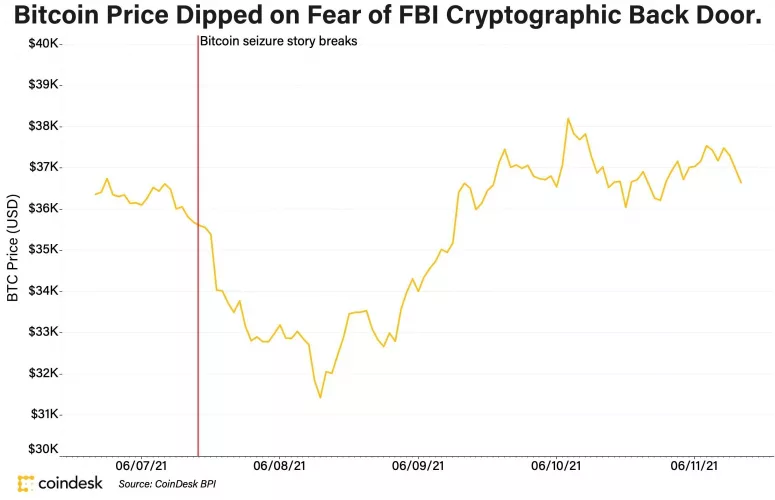This week, the cryptocurrency markets displayed a more sophisticated understanding of regulatory and technology risk.
I find it useful to think about risk in cryptocurrencies across three dimensions: market, technology and regulation. Like dimensions in space and time, they don’t exist independently; they intersect.
- The market risk dimension is the adoption risk facing any new technology. It's represented less by cryptocurrency critics than it is by people who just don't care.
- The technology risk dimension is the risk that the underlying technology will break. This may be the most-often overlooked. How many can say they understand why Bitcoin's SHA-256 hash function is unbreakable?
- The regulatory risk dimension receives the most attention, but its nuances are often poorly understood. Those nuances – and the market's slow progress toward grasping them – were on display in this week's string of news cycles.
This week was about regulatory and technology risk. It’s been amusing to watch commentators swing from wringing their hands about centralization of Bitcoin mining in China to wringing their hands about a Chinese government crackdown on Bitcoin mining.
Both risks are overemphasized. Mining is, alongside validation, Bitcoin’s system of governance. And Bitcoin commoditizes governance: It takes governance’s corrupting power and turns it into a “toothless commodity,” which anyone with an internet connection can supply. The only advantages in this race are cheaper energy and faster processors. North American miners have shown they can compete on both fronts.
Right now, any Chinese “crackdown” on cryptocurrency mining is North American miners’ digital-golden opportunity. And if Sen. Elizabeth Warren’s comments represent Washington’s intentions toward North American mining, that will be someone else’s opportunity. (A Paraguayan legislator this week made friendly regulatory overtures. Notably, Paraguay controls 45% capacity of Earth’s second-largest hydroelectric dam, and uses precious little of it.)
This week, the cryptocurrency markets displayed a more sophisticated understanding of regulatory and technology risk: shrugging off mining thunder from Washington and Beijing, and staggering at the news that U.S. federal law enforcement had found a way to seize bitcoin from Darkside, the criminal collective that held Colonial Pipeline’s systems for ransom.
It was the largest such seizure yet from a single, (presumably) sophisticated organization. Had the FBI cracked Bitcoin’s cryptography? The market reacted as if it had. A three-letter agency finding a way to crack hard problems in cryptography would indeed take the legs out from under Bitcoin and all cryptocurrencies (among other things). But that’s not what happened.
Hours after disclosing it had recovered bitcoin (BTC, +10.89%) sent to the Colonial Pipeline attackers, the FBI was named in a Europol press release describing a multinational operation in which law enforcement agencies stood up an encrypted-messaging service and marketed it to criminals as a Trojan horse. Inexplicably, these masters of deception seem to have entrusted this stool pigeon with their Bitcoin private keys.
The increasingly crypto-curious world has a thing or two to learn about how this works. The New York Times and The Wall Street Journal this week ran stories noting that bitcoin is “actually traceable” and citing “cryptocurrency’s reputation as hard-to-trace.” Law enforcement has long understood that crypto is not only traceable, but permanently traceable. Some waggish federals have referred to bitcoin as “prosecution futures,” journalist Nathaniel Popper noted in his 2016 book, “Digital Gold.”
The distinction between the U.S. government cracking SHA-256 (which it created) and setting up a sting via an off-chain service provider illustrates perfectly where the regulatory risk in cryptocurrency truly exists. The market’s reaction to the seizure news — and its non-reaction to a mid-week dip in Bitcoin hashrate or the news (some of it false) of Bitcoin bans in two Chinese provinces (Qinghai and Yunnan) — shows an improving understanding of this distinction.
Washington and Beijing would find it difficult stop Bitcoin mining, at least legislating it directly. As long as at least one computer is “running bitcoin,” Bitcoin runs. If bitcoin’s price rises, more miners will turn on, motivated by rewards and providing security commensurate with the value of the network. Stop up the entrance to her den, and the honey badger will to be sighted in another part of the forest.
Greater regulatory risk exists in government’s power to control crypto exchanges and other off-chain service providers. Crypto’s weird, fragmented liquidity performed admirably on May 19. That may not be the case in the next drawdown, depending how exchanges are regulated. There is also risk of slow progress on crypto-friendly regulation, such as banking oversight and a bitcoin ETF approval.
It’s not that mining is untouchable. Regulatory risk at the entrances and exits can have a negative effect on mining, by depressing the price. It’s important to distinguish between that and a regulatory risk that affects the security of Bitcoin itself.
The market seems to be gaining a better understanding of that distinction – between technology risk and regulatory risk in cryptocurrencies. That’s a sign of improving efficiency, at least for the time being. In the vacillation between retail- and institution-driven market cycles, that dynamic could change quickly.
All writers’ opinions are their own and do not constitute financial advice in any way whatsoever. Nothing published by CoinDesk constitutes an investment recommendation, nor should any data or Content published by CoinDesk be relied upon for any investment activities. CoinDesk strongly recommends that you perform your own independent research and/or speak with a qualified investment professional before making any financial decisions.
Recommended Content
Editors’ Picks
Uniswap nears $3 billion in daily trading volume despite Wells notice and fee hike

Uniswap's (UNI) price witnessed a double-fold crash in the past week after it received a Wells notice from the SEC and later due to the general crypto market crash over the weekend. In the past week, UNI has decreased more than 38%.
Arbitrum Price Prediction: 10% losses likely for holders ahead of $107 million worth of cliff token unlocks

Token unlocks are considered bearish catalysts, particularly when recipients are likely to cash in for a quick profit. The event, which adds tokens to the project’s circulating supply without increasing demand, leaves an effective imbalance in favor of supply.
Ethereum recovers from dip as Hong Kong ETH ETF approval sparks whale buying spree

Ethereum's (ETH) price slightly improved on Monday after Hong Kong approved applications for a spot Bitcoin and Ethereum ETF. Whales have also been accumulating ETH after the market dip over the weekend.
Bitcoin price delays pre-halving rally as US and China battle for BTC supremacy ahead of halving

Bitcoin has failed to showcase an enticing pre-halving rally. As the event remains less than a week out, traders and investors remain at the edge of their seats, with thoughts on whether the impact of the fourth cycle will be different than what has been seen before.
Bitcoin: BTC’s rangebound movement leaves traders confused

Bitcoin (BTC) price has been hovering around the $70,000 psychological level for a few weeks, resulting in a rangebound movement. This development could lead to a massive liquidation on either side before a directional move is established.
